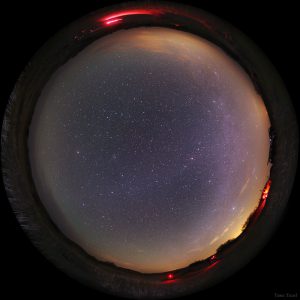Desert Camp and Zodiacal Band
Description
An all-sky view from Maranjab Desert of central Iran, made by taking and stitching several wide-angle photos. Red lights of other observers and photographers are recorded in the foreground. The winter Milky Way sets in the west over the light dome of nearby city of Kashan. Stretched from east to west is the faint glow of Zodiacal Light. The dust disk in our Solar System extending out to Jupiter’s orbit produces a faint glow all along the ecliptic, the path of the sun and planets in the heavens. This known as zodiacal light decreases in intensity with distance from the Sun, but on very dark nights it has been observed in a band completely around the ecliptic (as visible in this image). In fact, the zodiacal light covers the entire sky, being responsible for 60% of the total skylight on a moonless night. There is also a very faint, but still slightly increased, oval glow directly opposite the Sun known as the gegenschein (German for “counter glow”) which can be seen 180 degrees around from the Sun in an extremely dark sky (note this glow on the left center of the image between constellations Leo and Virgo). Click on the star-pattern icon above the image to see constellation lines and star names. Allow few moments for the flash video to load.
From the photographer” ” I was planning to take one all-sky picture like this for a long time, showing both Mars and Saturn high in the sky, as their oppositions would be less than 2 months apart. One bonus was Zodiacal Band and Gegenschein, recorded easily thanks to the darkness of the sky in the desert.”




comments (1)